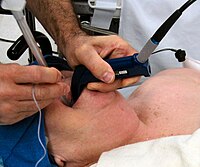
Photo from wikipedia
Background The optimal management of posterior cruciate ligament (PCL) injuries is debated by orthopedic surgeons. A natural history study (NHS) of acute, isolated PCL tears in patients with a mean… Click to show full abstract
Background The optimal management of posterior cruciate ligament (PCL) injuries is debated by orthopedic surgeons. A natural history study (NHS) of acute, isolated PCL tears in patients with a mean follow-up of 14.3 years was previously published. The purpose of this study was to compare and contrast the results of the NHS study with those of other studies with similar follow-up time after operative and nonoperative management of isolated PCL tears. Material and methods With reviewing the literature, six operative management and six nonoperative management studies were found for treating isolated PCL injuries. We analyzed the subjective and objective outcomes of these 12 studies and compared them to the results of the NHS to determine optimal management of PCL injuries. Results Final follow-up times ranged from a mean of 6.2 to 15 years in the nonoperative studies and 6.3 to 12 years in the operative studies. Side-to-side differences in laxity following surgical management ranged from 1.1 to 7 mm on KT-1000 arthrometer testing and 2.8 to 4.7 mm on Telos stress testing. Tegner scores at final follow-up ranged from 6.6 to 7.7 in nonoperative studies and 5.7 to 7.4 in operative studies. International Knee Documentation Committee scores were 73.4, 82.7, and 84 in nonoperative studies and 65 and 87 in the operative studies. Lysholm scores were 85.2 in the nonoperative study and ranged from 81 to 92.1 in operative studies. Osteoarthritis was reported with ranges from 17% to 88% in nonoperative studies and 13.3% to 63.6% in operative studies. Conclusion We found that the subjective and objective results in the NHS compare favorably to those of outcomes for PCL reconstruction. Unless a technique is found that can completely restore knee stability, it is unlikely that simply reducing posterior laxity will improve outcomes or prevent the development of osteoarthritis.
Journal Title: Orthopedic Research and Reviews
Year Published: 2017
Link to full text (if available)
Share on Social Media: Sign Up to like & get
recommendations!